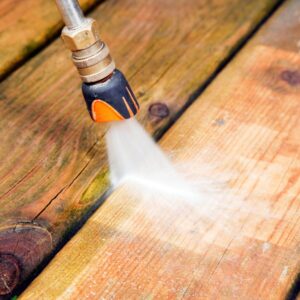
So you’ve got a beautiful timber deck that’s been enjoying the great outdoors and enduring the elements. However, it’s starting to look a little worse for wear, and you’re wondering how to give it a refresh without any damage. Enter sugar soap, the trusty cleaning solution that’s been a staple in many households. But can you use sugar soap to clean your timber deck? In this article, we’ll explore the possibilities and find out if sugar soap is the secret ingredient to restoring your deck’s former glory. So grab your cleaning gloves and let’s dive into the world of timber deck maintenance!
Using Sugar Soap to Clean Timber

What is sugar soap?
Definition of sugar soap
Sugar soap is a type of cleaning solution that is commonly used for a wide range of household cleaning tasks. It is a versatile cleaning product that is especially effective in removing dirt, grime, and grease from various surfaces. Sugar soap is known for its cleaning potency and gentle nature, making it a popular choice for many cleaning applications.
Ingredients of sugar soap
Sugar soap typically contains a combination of chemicals and natural ingredients that work together to provide effective cleaning results. The main ingredients typically include surfactants, such as sodium carbonate or sodium phosphate, which help to break down and remove dirt and grease. Other ingredients may include water, sodium bicarbonate, potassium hydroxide, and fragrances.
Uses of sugar soap
Sugar soap can be used for a variety of cleaning tasks around the house, including cleaning walls, floors, tiles, countertops, and surfaces made of plastic or metal. It is also commonly used as a pre-painting cleaner to remove grease, dirt, and other contaminants from walls and ceilings. The versatile nature of sugar soap makes it a valuable cleaning product for both everyday cleaning and more specific cleaning needs.
Understanding timber decks
Definition of timber decks
Timber decks are outdoor platforms or structures made from various types of wood, typically used to extend living spaces and provide a comfortable area for relaxation and entertainment. Timber decks can greatly enhance the aesthetics and functionality of a space, adding value to the property. They are often built as an extension of a home or as a standalone feature in a garden or backyard.
Common types of timber used for decks
There are several common types of timber used for decks, each with its own unique characteristics and advantages. Some popular choices include:
- Pine: Pine is a widely available and affordable option for timber decks. It is known for its durability and resistance to decay. However, it may require regular maintenance and treatment to protect it from weathering and insect damage.
- Cedar: Cedar is a popular choice for timber decks due to its natural resistance to decay and insect infestation. It has a beautiful appearance with its distinct grain patterns and natural reddish or golden hues. Cedar decks require regular maintenance to preserve their appearance and protect against weathering.
- Redwood: Redwood is a premium option for timber decks, known for its natural beauty and exceptional durability. It has a rich, reddish-brown color and a high resistance to decay and insect damage. Redwood decks can be more costly upfront and require regular maintenance to keep them looking their best.
Maintenance requirements for timber decks
Timber decks require regular maintenance to ensure their longevity and optimal appearance. Some essential maintenance tasks include:
- Regular cleaning: Timber decks should be regularly cleaned to remove dirt, debris, and stains that can accumulate over time. Regular cleaning also helps to prevent the growth of mold and mildew.
- Sealing: Applying a protective sealant to timber decks helps to enhance their durability and resistance to weathering and insect damage. Sealants provide a barrier against moisture and UV radiation, prolonging the life of the deck.
- Stain or paint: Timber decks can be stained or painted to enhance their appearance and protect the wood from damage. Stains and paints offer protection against UV radiation, moisture, and mildew growth. It is important to follow the manufacturer’s recommendations when choosing a stain or paint specifically designed for outdoor use.
Cleaning a timber deck
Why is it important to clean a timber deck?
Regular cleaning of a timber deck is essential to maintain its integrity and appearance. Over time, dirt, grime, and debris can accumulate on the surface, making the deck look dull and potentially causing damage to the wood. Neglecting regular cleaning can lead to the growth of mold, mildew, and algae, which can further deteriorate the deck and pose safety hazards.
Common methods for cleaning timber decks
There are several common methods for cleaning timber decks, depending on the level of dirt and staining. Some popular cleaning methods include:
- Sweeping and scrubbing: Regular sweeping with a broom and gentle scrubbing with a soft-bristle brush can effectively remove loose dirt and debris from the deck. This method is suitable for routine cleaning and maintenance.
- Power washing: Power washing, also known as pressure washing, utilizes a high-pressure stream of water to remove dirt, grime, and stains from the timber deck. This method is more effective in deep cleaning and removing stubborn stains, but it should be used with caution to avoid damaging the wood.
- Chemical cleaners: Specialized deck cleaners are available in the market, formulated to effectively remove deep-seated stains, mold, and mildew. These cleaners often require dilution and should be applied according to the manufacturer’s instructions. It is important to thoroughly rinse the deck after using chemical cleaners to minimize any potential residue.
Potential issues when cleaning timber decks
While cleaning a timber deck is important, it is essential to be aware of potential issues that may arise during the cleaning process. These issues include:
- Damage due to high-pressure cleaning: Power washing can potentially damage the timber deck if not done properly. The high-pressure stream of water can strip away the wood’s natural oils, cause splintering, and leave marks or etchings on the surface.
- Residue buildup: Improper rinsing or excessive use of cleaning chemicals can lead to residue buildup, leaving the deck sticky or slippery. This residue can attract dirt and grime, making the deck appear dirty even after cleaning.
- Inadequate protection: The cleaning process can remove the wood’s natural oils and protective sealants. If not properly resealed or maintained, the deck may become vulnerable to moisture, UV radiation, and insect damage.
Can sugar soap be used to clean timber decks?
Advantages of using sugar soap
Using sugar soap to clean timber decks offers several advantages. These include:
- Effectiveness in removing dirt and grime: Sugar soap is known for its cleaning potency, making it effective in removing dirt, grime, and grease from timber surfaces. It can help restore the natural beauty of the deck by lifting away accumulated debris.
- Gentle on timber surfaces: Unlike harsh chemical cleaners, sugar soap is generally gentle on timber surfaces. It is less likely to cause damage or discoloration when used correctly. This makes it a safer option for regular cleaning and maintenance.
- Readily available and affordable: Sugar soap is widely available in most stores, making it easily accessible for consumers. Additionally, it is generally more affordable compared to specialized deck cleaners or other cleaning solutions, providing a cost-effective option for cleaning timber decks.
Disadvantages of using sugar soap
While sugar soap offers several advantages, there are also some disadvantages to consider. These include:
- Limited effectiveness on tougher stains: Sugar soap may not be as effective in removing tough stains, such as deep-seated oil stains or mold and mildew. In such cases, a specialized deck cleaner or other stain removal methods may be more suitable.
- Potential residue buildup: Depending on the concentration and application of sugar soap, there is a possibility of residue buildup on the timber deck. This residue can attract dirt and grime, making the deck appear dirtier over time.
- May require additional rinsing: Sugar soap may require thorough rinsing to remove any potential residue. Failure to rinse adequately can lead to the formation of sticky or slippery residues on the deck surface, which can be unsightly and hazardous.
Considerations before using sugar soap on timber decks
Before using sugar soap to clean a timber deck, it is important to take certain considerations into account. These considerations include:
- Checking the manufacturer’s recommendations: Different sugar soap products may have specific instructions or recommendations for use. It is important to carefully read and follow the manufacturer’s instructions to ensure safe and effective use on timber decks.
- Testing on a small inconspicuous area: Before applying sugar soap to the entire deck, it is advisable to test it on a small inconspicuous area first. This will help determine how the timber reacts to the cleaning solution and whether any adverse effects, such as discoloration or damage, occur.
- Considering the type and condition of the timber deck: The type of timber used for the deck and its current condition should be taken into consideration. Delicate or weathered timber may require extra caution, and sugar soap may not be the best choice for heavily stained or damaged decks.

Alternative cleaning methods for timber decks
While sugar soap can be a viable option for cleaning timber decks, there are also alternative methods available. These include:
Pressure washing
Pressure washing, when done correctly and with the appropriate equipment, can effectively remove dirt, grime, and stains from timber decks. However, it is important to adjust the pressure settings and use the correct nozzle to avoid damaging the wood’s surface.
Bleaching agents
Bleaching agents, such as oxygen bleach or chlorine bleach, can be used to remove tough stains and discoloration from timber decks. These agents should be used with caution and according to the manufacturer’s instructions to prevent damage to the wood.
Specialized deck cleaners
There are numerous specialized deck cleaners available in the market that are specifically formulated for timber decks. These cleaners often target specific stains, mold, and mildew, providing a more tailored approach to cleaning. It is important to choose a deck cleaner that is suitable for the type of timber and the specific cleaning requirements.
Tips for cleaning timber decks
Cleaning a timber deck can be an easier and more efficient process by following these helpful tips:
Sweeping and removing debris
Before starting the cleaning process, sweep the deck surface to remove loose debris, leaves, and dirt. This will prevent the debris from being further spread and potentially scratching the deck during the cleaning process.
Using protective gear
When using any cleaning solution or chemicals, it is important to wear appropriate protective gear. This includes gloves, safety goggles, and closed-toe shoes to protect your skin, eyes, and feet. Additionally, consider wearing old clothing that can be stained or damaged during the cleaning process.
Minimizing the use of harsh chemicals
If opting for chemical cleaners, it is advisable to use them sparingly and strictly according to the manufacturer’s instructions. Overuse of harsh chemicals can lead to damage or discoloration of the timber deck. Whenever possible, choose more gentle and environmentally friendly cleaning options.

Conclusion
In conclusion, using sugar soap to clean timber decks can be a viable option for routine cleaning and maintenance. Sugar soap offers several advantages, including its effectiveness in removing dirt and grime, its gentle nature on timber surfaces, and its affordability and accessibility. However, there are also some disadvantages to consider, such as limited effectiveness on tougher stains, potential residue buildup, and the need for thorough rinsing. It is important to weigh the pros and cons before deciding to use sugar soap and to consider personal preferences and the specific requirements of the timber deck. Seeking professional advice is recommended if uncertain about the cleaning process or if the deck requires specialized treatment. With proper care and regular maintenance, a timber deck can provide years of enjoyment and enhance the overall aesthetics of a space.












